Engaged Anthropology Grant: Erin Masterson
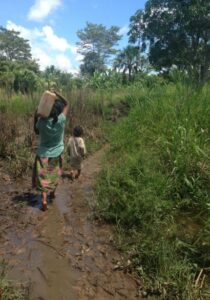
While a doctoral student at the University of Washington, Erin Masterson received a Dissertation Fieldwork Grant in 2014 to aid research on “Putting Teeth into the Developmental Origins Hypothesis: Early Childhood Ecology, Enamel Defects and Adolescent Growth,” supervised by Dr. Daniel Eisenberg. In 2017 Dr. Masterson received an Engaged Anthropology Grant to aid engaged activities on “Initiation of a Clean Water Campaign to Improve Children’s Health and Development in Bolivia’s Amazon.”
With support from the Wenner-Gren Foundation, in 2018 I returned to Bolivia’s Amazonian Basin for a month to visit the 12 Tsimane’ communities that participated in my dissertation research in 2015. This follow-up visit included an aim to initiate a clean water campaign in the Tsimane’ Territory of the Bolivian Amazon. I was motivated to focus on this topic because my dissertation research findings underscored the importance of a healthy, infection-free childhood for long-term health.

Specifically, I reconnected with my Bolivian colleagues at the Centro Boliviano de Investigación y Desarrollo Socio (CBIDSI) and we set out to: (1) to develop a logo and slogan in the native Tsimane’ language to motivate clean water stewardship, (2) to develop educational materials focused on the risks of parasitic and bacterial infections and the importance of clean water, and (3) to make structural changes in schools by implementing water filters and hand washing stations. The idea for this project was developed directly from my time in the field in 2015, observing and discussing behaviors and thoughts related to water use with community members and my CBIDSI colleagues. Community leaders requested educational information in the native Tsimane’ language, like the oral health workshop we offered during data collection. A primary health concern that was expressed during these workshops was pediatric diarrhea and other infection- related conditions. Although education was the foundation of this project, we also implemented structural changes to enable the positive behavior changes encouraged through education.
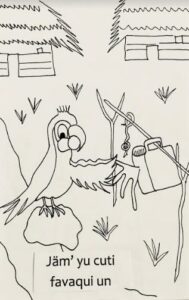
First, we developed a label with a parrot “mascot” and the phrase “clean water” in the native Tsimane’ language to attach to all aspects of this project. The idea of this was that repetition will help to reinforce educational messages and recognition of all aspects of the project as parts of one end goal: clean water. We developed a set of posters to guide an educational talk about how water becomes contaminated and causes illness, how to keep water clean, and good hygiene practices to prevent contamination. We wrote the script in Spanish and translated it to the native Tsimane’ language. The talk was then recorded in both Spanish and Tsimane’ is being broadcasted on the local radio, a form of communication accessible in nearly all Tsimane’ communities. To provide a more in-depth understanding of why it is important to keep water clean and to then offer suggestions for how to accomplish this in the home, we developed and distributed coloring books with text in the native Tsimane’ language that instructed how to keep water clean in the home and practice good hygiene.
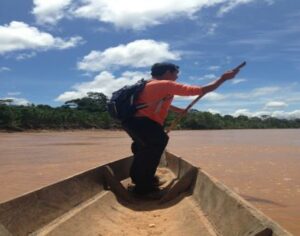
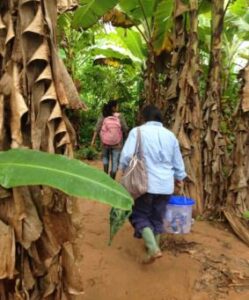
Based on the idea that implementing structural changes fosters positive behavior change, we provided each school with one Sawyer PointONE filter with a bucket adaptor kit. We hand delivered the filter kit to each community, already set-up, labeled, with photo instructions for caring for the filter, and tested for leaks. We put the filter in the hands and care of the school teacher in each community. When we visited the communities, we invited the teacher, students and community members to participate in a demonstration on using the water filter and a brief training workshop on caring for it. Due to weather that complicated our river travel plans to visit the communities, our time was too limited to actually build the “tippy-tap” handwashing stations with the communities, but we discussed the plans and purpose of these stations in detail with the teachers and community members in each community. We also provided them with photo instructions on how to construct this simple structure. The hope is that, because people tend to develop new behaviors more readily at a younger age, students will hopefully bring these new ideas and habits home to their families.
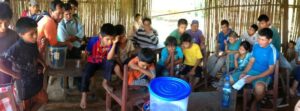
Through all these activities, we engaged children, teachers, families, community leaders and the local Tsimane’ government leaders. We encountered profound and widespread support of our focus on clean water stewardship, motivated by desperation to mitigate the ill effects of parasitic and bacterial infection in the Tsimane’ communities. This project contributed to generating an equitable relationship between myself and the Tsimane’ people, because I was able to share my study findings with them in an applied and relevant manner, through offering information around and suggestions for improving children’s health and development in their native language.
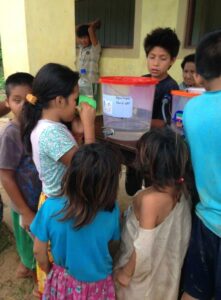
Finally, prompted by the overwhelming enthusiasm and demands for a filter for each household while visiting the communities, my CBIDSI colleagues and I embarked on a feasibility study to initiate local production of ceramic water filters during my visit so that, as requested in the communities, all households may one day have a filter and clean water. This entailed hours of meeting and discussing, reviewing potential property layouts, equipment and material sourcing opportunities and pricing, and collecting and lab testing the local clay material for mineral and physical properties.
We composed a report summarizing our investigation which will be used to seek start-up funds for this subsequent project, which will continue to work toward the ultimate goal of reducing childhood morbidity attributed to contaminated water.